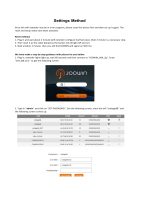
CONTENTS
Chapter 1 Introduction
.......................................................................................................................... 1
1.1 System Requirement
..................................................................................................................... 1
1.2 Package Contents
......................................................................................................................... 1
1.3 Conventions................................................................................................................................... 2
Chapter 2 Hardware Co
nnection.......................................................................................................... 3
2.1 Before Y
ou Begin........................................................................................................................... 3
2.2 LED Indicator................................................................................................................................. 4
2.3 Physical Interface .......................................................................................................................... 5
2.4 Hardware Connection.................................................................................................................... 5
2.5 Wi-Fi Clone Button for Super Range Extension
............................................................................. 8
Chapter 3 Configure the Device
......................................................................................................... 10
3.1 Login............................................................................................................................................ 10
3.1.1 For Wired Connection
........................................................................................................... 10
3.1.2 For Wireless Connection
....................................................................................................... 12
3.2 Status
........................................................................................................................................... 13
3.3 Network ....................................................................................................................................... 14
3.4 Wireless
....................................................................................................................................... 15
3.4.1 Wireless Settings .................................................................................................................. 15
3.4.2 Wireless Security
.................................................................................................................. 17
3.4.3 Wireless MAC Filtering.......................................................................................................... 19
3.4.4 Wireless Advanced ............................................................................................................... 21
3.4.5 Wireless S
tatistics ................................................................................................................. 22
3.5 Powerline..................................................................................................................................... 23
3.5.1 Network Set
tings................................................................................................................... 23
3.5.2 Station Settings ..................................................................................................................... 23
3.6 System Tools ............................................................................................................................... 25
3.6.1 Firmware Upgrade
................................................................................................................ 25
3.6.2 Factory Defaults.................................................................................................................... 27
3.6.3 Backup & Restore
................................................................................................................. 27
3.6.4 Reboot .................................................................................................................................. 28
3.6.5 Passw
ord .............................................................................................................................. 28
3.6.6 System Log ........................................................................................................................... 29
Chapter 4 Connecting to W
ireless Network...................................................................................... 30
4.1 In Windows 8
............................................................................................................................... 30
4.2 In Windows 7
............................................................................................................................... 31
4.3 In Windows V
ista ......................................................................................................................... 33
4.4 In Windows XP ............................................................................................................................ 35
Chapter 5 Pair Button
......................................................................................................................... 37
5.1 Pair (Secure with 128 bits-AES) .................................................................................................. 37
5.2 Setting Up a Powerline Network with the Pair Button .................................................................. 37
5.3 Reset ........................................................................................................................................... 38
Appendix A: Troubleshooting Guid
e ................................................................................................. 39
Appendix B: Specifications
................................................................................................................ 40




















